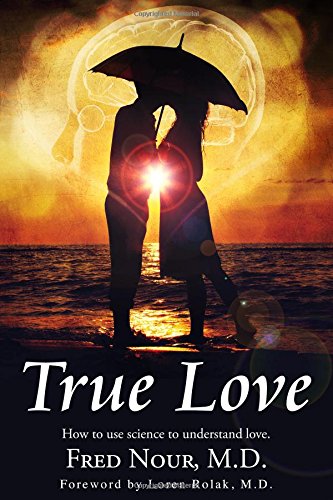Fred Nour, M.D., True Love:
How To Use Science To Understand Love
reviewed by Alison McBain

True Love: How To Use Science To Understand Love Publisher: Niguel Publishing, Inc. Date: February 2, 2017 Length: 288 pages ISBN: 099840439X; 9780998404394 |
For those who know me, you'll know that I tend to pick up any genre that catches my interest, which is pretty much any genre. I've written book reviews on science fiction, fantasy, horror, literary, mainstream, romance, history... you name it, I've read it and written it.
Recently, I've been writing romance. For fans of the genre, you'll know that there are certain tropes and plotlines that continually appear in romance novels. But that brings up the question of why they are popular. What causes people to behave in a certain way when they approach romance, to the extent that romantic behavior can easily be predicted?
In addition to romance, I also write science fiction. For research, I love to read any science articles I can get my hands on. I like to discover what causes events and happenings around the world and beyond. How does everything work?
Fred Nour's book True Love: How to use science to understand love combines these two ideas by trying to explain the medical science behind love. Mr. Nour is a neurologist whose book attempts to shed light on what chemicals cause and maintain love, and how best to use this knowledge to form what he calls “True Love,” or a permanent, beneficial relationship.
While the phrase “True Love” immediately brought to mind The Princess Bride for me — and for any other fans of the fantasy genre, I imagine — I thought this would be a great way to shed some light on the genre of romance.
Mr. Nour approaches the situation like a scientist, laying out his ideas in an ordered approach with supporting evidence for his theories. First, he examines the idea of the existence of love by highlighting examples from human history and entertainment, animal and human experiments, and personal experience. He brings up poems from thousands of years ago, old and modern love songs, studies of the behavior of different animal and human interactions, and examples of people he has known and/or worked with.
He breaks love up into four phases. Phase one is the mate-selection process; phase two is romantic love/falling in love; phase three is falling out of love; and phase four is “True Love.” To show how the brain processes each phase of love, he talks about the chemicals released in the brain associated with the different stages of love, from monoamines to nonapeptides, how these chemicals work, including side effects and how they're related to mental disease. He finishes with how a person can best use this knowledge to find a compatible mate.
This book is a cross between a scientific paper, a historical article, a self-help book and a memoir. I especially found the science and history aspects of the studies very interesting, and how Mr. Nour relates his findings and theories to practice and observed behavior.
While I don't think this book is for everyone — some of the science gets pretty heavy, and someone who might not like scientific articles would probably find it a bit dense to wade through — I enjoyed learning more about the human brain and how it works in connection to love. While I can't comment on the veracity of the science, not being a neurologist myself, it seemed clearly explained, and had examples and charts to guide readers who aren't intimately familiar with biological processes.
One part in particular I found interesting and maybe a little amusing: Mr. Nour specifically chronicles that the same chemicals in the brain involved in love are also involved in types of mental disease. So the idea that a person can be “crazy in love” has a somewhat scientific basis, although he very clearly stresses that the two are not the same thing, even though the chemical interactions in the brain may cause some similar behaviors.
For readers who wouldn't mind learning a bit about the science behind love, this book would be of interest. Mr. Nour is also quite up-front that some of his theories are just that: theories he has but that other medical experts might disagree with. The brain, while extensively studied, is not an open book. But for all you scientific romantics out there, this book might be a good place to start.
Copyright © 2017 by Alison McBain

